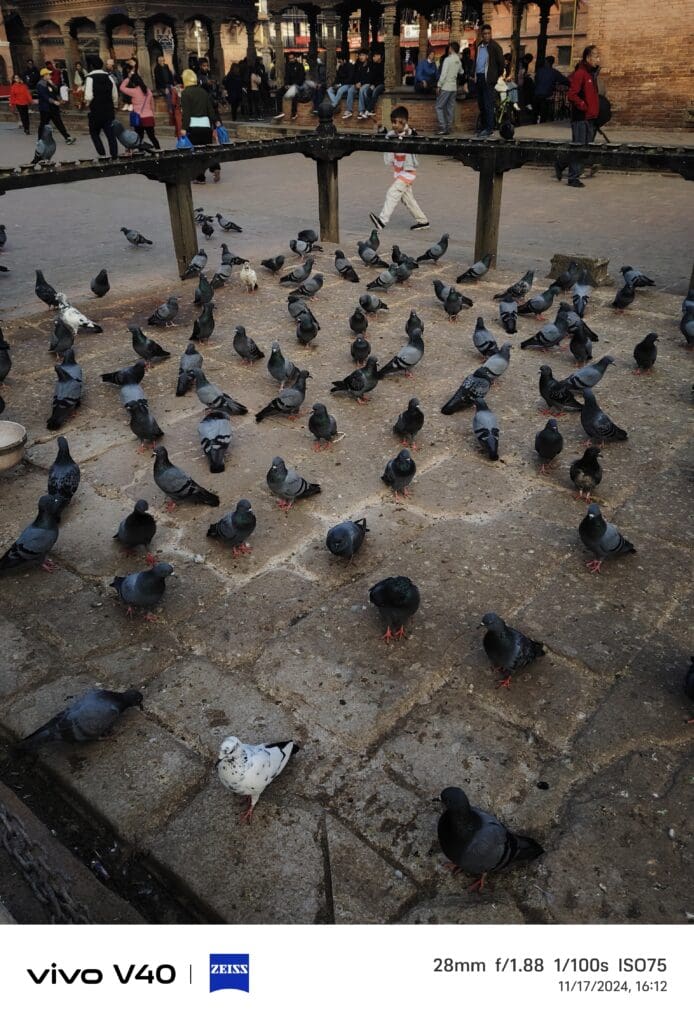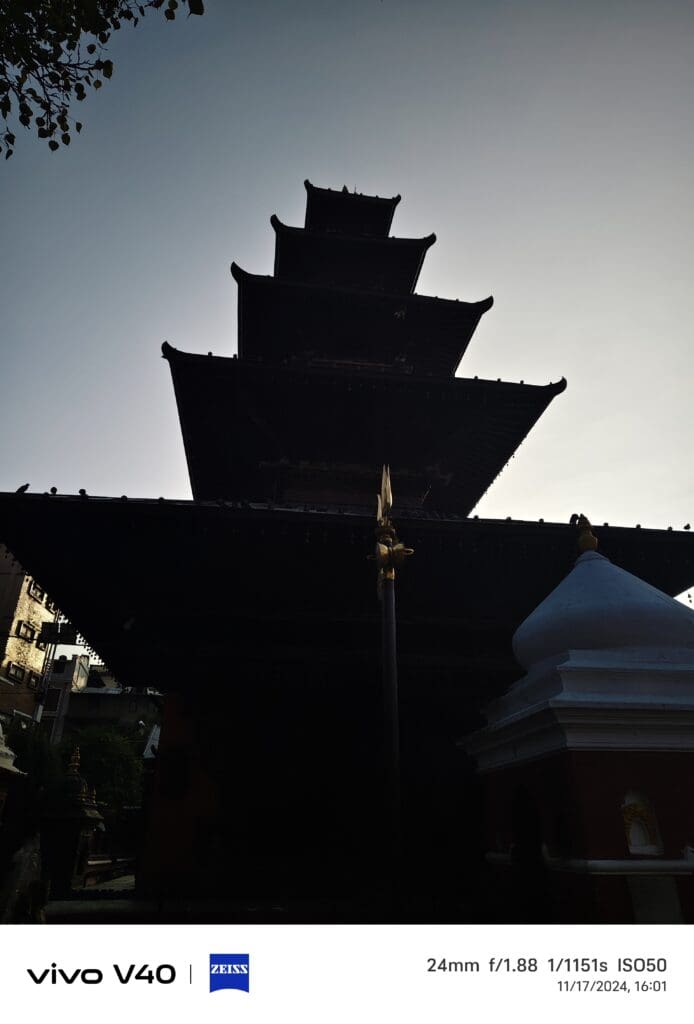Vivo recently launched its V40 series in Nepal, and the biggest highlight this time is that both handsets in the series feature ZEISS optics. Previously, ZEISS branding for the cameras was limited to the Pro variants of the V series, but now the base variant also includes LUTs and imaging systems co-engineered with the tech giant. However, the upgrades go beyond just the optics.
While the V30 had a moderate IP54 dust and water resistance rating, the V40 has made a significant leap to an IP68 rating. Additionally, it offers a larger battery and a better display compared to the Vivo V30. The question now is whether these upgrades are enough to compete with other phones in Nepal’s highly competitive smartphone market. Let’s find out in this Vivo V40 Full Review.
Table of Contents
Vivo V40 Full Review, Detailed Analysis, Pros and Cons with Reviewer’s Ratings
Design

Unlike other brands that make small changes to their phones with each new release, Vivo takes a bold approach by completely redesigning its devices for every series. This time, the Vivo V40 features a circular camera module positioned at the top-left corner of the back, with a stylish Aura Light ring placed right beneath it. The phone has a sleek look with curved sides and a glass back. While I’m not usually a fan of this design combination, I must admit it works well here, giving the V40 an elegant and minimalist appearance.
When I first saw the phone’s renders, I was unsure about the design. However, seeing the Titanium Grey color in person changed my perspective. Not only does it look appealing, but it also feels comfortable to hold. The phone also comes in two other colors: Lotus Purple and Ganges Blue, offering something for different tastes.

One of the standout features of the Vivo V40 is its slim and lightweight design, especially impressive considering it packs a large 5,500mAh battery. At just 7.6mm thick and weighing 190 grams, it’s one of the thinnest phones with a battery of this size. Its curved design and light weight make it easy to hold and operate with one hand. On top of that, the phone is IP68-certified for dust and water resistance, meaning it can survive in up to 1.5 meters of still water for 30 minutes.
Display
The Vivo V40 comes with a large 6.78-inch AMOLED display that offers a resolution of 1260×2800 pixels, a smooth 120Hz refresh rate, and an incredibly bright peak brightness of 4,500 nits. Thanks to its pixel density of 453 pixels per inch (ppi), the screen looks very sharp and delivers excellent viewing angles. The display also performs well outdoors, staying bright and clear even under direct sunlight.

The screen has curved edges, which might appeal to some users but may not be everyone’s preference. I usually prefer flat screens, as they avoid accidental touches and generally have better viewing angles. However, the curved edges on the Vivo V40 do give the display a sleek and immersive look, especially if ambient light isn’t a concern.

The display stands out with its quick response time, vibrant colors, and high contrast ratio. Whether you’re watching videos, playing games, or scrolling through apps, the V40 offers an impressive viewing experience.
Performance
The Vivo V40 introduces several notable upgrades, but its processor remains unchanged from its predecessor, featuring the Snapdragon 7 Gen 3 chipset—a popular choice for phones in this price range. The device offers up to 12GB of LPDDR4X RAM and 512GB of UFS 2.2 storage, though the unit I tested had 8GB of RAM and 128GB of storage. Additionally, it supports 12GB of extended RAM, allowing it to handle demanding tasks and run over 40 apps in the background without frequent reloads.

To evaluate its performance, we compared it to the Realme GT 6T and Motorola Edge 50 Pro using various benchmark tests. In the AnTuTu benchmark, which measures overall performance, the Realme GT 6T, powered by the superior Snapdragon 7+ Gen 3 chipset, emerged as the winner, followed by the Edge 50 Pro, which slightly outperformed the V40 despite using the same chipset.

In the Geekbench test, which assesses CPU and GPU performance, the Realme GT 6T led again, but the V40 outperformed the Edge 50 Pro, proving its ability to handle CPU-intensive tasks effectively. Lastly, in the Burnout test, which measures sustained performance under heavy load, the Edge 50 Pro came out on top, with the V40 close behind, while the Realme GT 6T faced significant throttling. Overall, the Vivo V40 delivers solid performance and efficiently manages demanding tasks, even though it doesn’t surpass the Realme GT 6T in benchmarks.

Os and UI
The Vivo V40 comes with Android 14-based FunTouchOS 14 right out of the box. It has about 51 pre-installed apps, but they don’t feel intrusive or unnecessary. The user interface is clean, and combined with the 120Hz refresh rate, navigating the phone feels smooth and responsive. FunTouchOS 14 doesn’t bring any major changes compared to what we saw in the V30 or V40 Pro. It still includes features like the V-Appstore (Vivo’s app store), iManager (a tool for cleaning up your phone and scanning for security issues), and Jovi Home, an AI assistant that provides personalized recommendations based on your usage habits.

Camera
The Vivo V40 features a dual-camera system, headlined by a 50MP primary sensor with an f/1.9 aperture, a large 1/1.55-inch sensor size, PDAF (phase detection autofocus), and OIS (optical image stabilization) for stable and clear photos. It is supported by a 50MP ultra-wide camera with a 119-degree field of view, a 1/2.76-inch sensor size, and autofocus. Co-engineered with ZEISS, the camera setup is designed to enhance photography with advanced features and professional-grade capabilities. Additionally, the V40 introduces the Studio Quality Aura Light, a circular flash system aimed at providing soft and natural lighting for low-light photos. Unlike regular flash that often overexposes images, this feature delivers better results by avoiding harsh lighting.

The V40’s ZEISS partnership brings specialized multi-focal portrait modes, allowing users to take professional-style portraits at different zoom levels, such as Landscape Portrait (24mm), Street Portrait (35mm), and Natural/Classic Portrait (50mm). It also excels at edge detection and offers a wide variety of ZEISS Style Bokeh effects, including Cinematic, Cine-flare, Planar, Sonnar, and Biotar, which add creative flair to portrait shots. For additional fun, the camera includes various LUTs (color filters) tailored for special occasions, keeping photography interesting and dynamic.






In daily photography, the V40 captures aesthetically pleasing shots in all lighting conditions. However, while the images look good overall, they sometimes lack fine details, especially when zooming in. This lack of sharpness is more noticeable near the edges of photos, which might disappoint users looking for precise image quality across the frame.
When compared to competitors like the Motorola Edge 50 Pro, the V40’s performance varies depending on the scenario. In daylight shots, the Edge 50 Pro oversaturated colors, while the V40 offered better color accuracy but struggled with edge sharpness. For ultra-wide shots, the V40 performed similarly, slightly boosting colors but failing to capture sufficient detail. However, in portrait photography, the V40 stood out, delivering the best results among competitors. It produced natural-looking portraits with excellent edge detection and a variety of bokeh effects that elevated the overall experience.






In the selfie department, the V40 excelled, providing accurate skin tones and a good level of detail, making it the best performer among the tested devices. However, in low-light photography, the V40 struggled with overexposing images, making them appear unnaturally bright, while the Edge 50 Pro handled exposure more effectively, resulting in more realistic photos.



Battery and Charging
The Vivo V40 is powered by a 5,500mAh battery with 80W fast charging support, providing solid battery life for everyday use. By the end of most days, I still had some charge left, which is always a positive. In our PCMark battery test, the phone lasted 13 hours, which is similar to what other phones in this price range offer.

For gaming, we tested the battery by playing three popular games—BGMI, Real Racing 3, and Call of Duty: Mobile—for 30 minutes each. After 90 minutes of gaming, the battery dropped by 16%, which is lower than many competitors. This shows that the V40 is more battery-efficient when handling heavy tasks like gaming.
Pros and Cons
| Pros | Cons |
| Slim Design | Same chipset as its predecessor |
| Better Display | Cameras struggle with capturing details |
| Impressive portrait photography | |
| Bigger Battery |
Verdict
The Vivo V40 brings some nice upgrades compared to its predecessor but sticks with the same processor. Priced at NRP 65,999, it’s more expensive than the Realme GT 6T, which offers better performance. However, the V40 stands out with its good battery life, slim and stylish design, bright and colorful display, and decent cameras. While its general software doesn’t have as many features as some competitors, the camera software is excellent. That said, the phone does struggle to capture fine details in certain shots. If you can overlook this, the Vivo V40 is a solid option, especially for those who prioritize design and camera quality.







